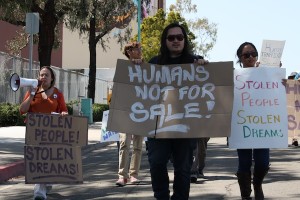
A dark shadow currently lurks within the alley ways of Southern California.
Beaten, tortured, forced to perform hard labor and raped on a weekly basis; this is what many men, women and children have to go through in San Diego County and throughout the rest of the country.
The Victims Protection Act defines human trafficking as the use of force, fraud or coercion for the purpose of labor or sex trafficking, and according to the San Diego District Attorney’s website, the FBI has listed San Diego as one of the 13 most intense child prostitution areas.
Palomar College’s Child Development Club hosted an event on Oct. 7 in the MD Building, where Crystal Anthony, who is the Project Coordinator for the North County Lifeline, spoke about the dangers of human trafficking, especially in San Diego and North County.
According to the State of Human Trafficking in California 2012, 56 percent of victims were sexually trafficked, while only 23 percent were trafficked for labor. Anthony elaborated that labor trafficking can be difficult to identify.
“Labor trafficking is much harder to see,” Anthony said. “There’s way more beneath the surface there. It could be somebody that’s working, or it looks like they’re working … sex trafficking is what we have come across the most.”
In a press release from 2011, the FBI, along with many other agencies, charged 38 people, many of which were members of gangs, for the prostitution of minors and adults, with the addition of other gang related crimes at the Oceanside Travel Lodge in Oceanside. Many of these young women were recruited through social media and they suffered many forms of abuse while they were held captive.
Susan Munsey is a survivor of human trafficking, and the executive and founder of Generate Hope, which is an organization that assists survivors of human trafficking in the long term. Munsey said that most victims are raped at least once a week, 64 percent are threatened at some point with a weapon and 70-90 percent have been physically assaulted.
According to Anthony, many times in colleges and universities, students who are struggling with paying for school, and other finances, tend to be vulnerable to being trafficked.
Traffickers will send recruiters to colleges and universities to entice students into trafficking with the promise that they will make money.
In an attempt to combat this issue, many countries, like Germany have legalized prostitution. But Autumn Burris, founder and director of the for-profit organization called Survivors for Solutions and a former graduate of Palomar College, disagrees with this stance. Burris, who is also a survivor of sexual exploitation, stated that prostitution in all forms is considered rape.
“The simple fact alone that you’re performing a sex act, or having one performed on you, without consent, with money is compensated rape,” Burris said.
Burris proposes another alternative which is, instead of legalizing prostitution, the U.S. should decriminalize the exploited individual and criminalize of the sex buyer. This method is what Burris describes as the Nordic Model.
Burris explained that this would decrease the demand of prostitution, which would ultimately diminish the supply.
As a survivor of sexual exploitation, Burris explained what happened to her personally. She was taken to her first strip club by organized crime, where she eventually became desensitized and a prostituted woman.
Burris explained the horrible conditions that she was in as a prostituted woman. On one occasion, she got into a truck with a sex buyer who, according to Burris, seemed unstable. She said that she tried to escape, but the door handle didn’t work.
According to Burris, the man went on to beat, rape and throw her on the street for dead. Within an hour she was being bought by another sex buyer.
Yuriko Farrel, 25, was one of the many people who went to the human trafficking event at Palomar. She expressed how shocked she was about the many different types of people who are drawn into the world of human trafficking.
“It’s not just women, it’s all kinds of people,” Farrel said. “Children as young as nine years old being exploited by these pimps, it’s just disgusting.
“So I just don’t understand how people get to these kids like that. I have kids of my own. I would never want to see them in this kind of situation.”
Image Sources
- humantrafficking: Photo courtesy of Eva Posner/San Diego Uptown News | All Rights Reserved
